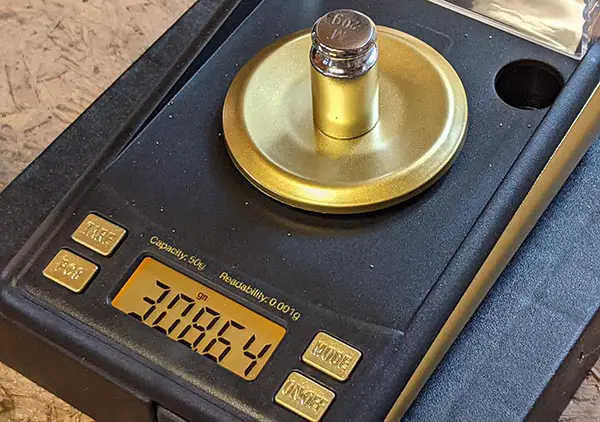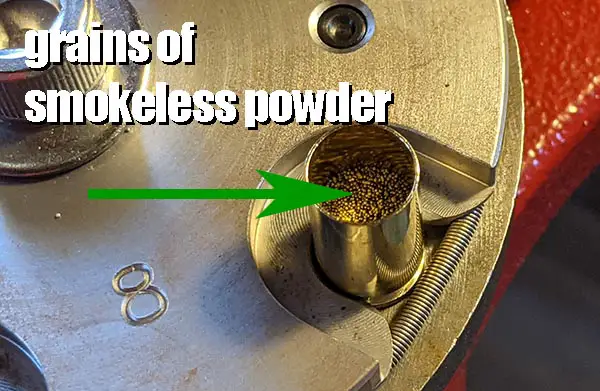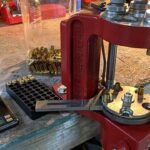If you’ve picked up your ammunition at your local sporting goods or gun store, you’ve likely notice the number on the side followed by “gr,” “gn,” or “grains.” So what does grain mean when we talk about ammunition? Grains are a unit of weight measurement, the grains on a box of ammunition describe the weight of the projectile not the powder charge. Therefore, the higher the grain the heavier the bullet and lower the grain the lighter the bullet.
Table of Contents
What Is Measured In Grains?

20g weight on a digital scale converted to measure in gr
Because grains describe weight, there are other parts of ammunition that utilize this unit of measurement. The powder charge — the smokeless powder inside the casing — is also measured in grains.
However, when you are buying a box of ammunition the grains printed on the side refer to the bullet weight and not the powder charge. Grains are used to measure weight, and as such, can be converted to grams, pounds (lbs.), or any other unit of weight measurement. However, it is usually reserved for small weights and I have only ever experienced something measured in grains when discussing ammo.
Is Higher Grain Ammo Better?
Higher grain ammunition — or heavier bullets — can be a good thing depending on your needs. In my recent firearm instructor course, I spoke with a competition 3 gun shooter. He finds higher grain ammo better for knocking down steel targets.
If you need to generate more “stopping power” then a heavier grain bullet is going to be better. For instance, if two bullets with different grains exit the muzzle with identical velocity the heavier bullet will generate more momentum.
Contrarily, if you need to maximize accuracy over distance then a smaller grain bullet may be beneficial. If two cartridges are loaded with the same charge, the lighter bullet will achieve greater velocity which translates to a longer distance.
Does Higher Grain Ammo Have More Powder?

Powder charge for a 115gr 9mm bullet before loading
If a higher grain bullet is heavier, then does it require a greater powder charge? Higher grain ammo does not necessarily have a larger powder charge. In fact, sometimes a heavier bullet requires a smaller powder charge to achieve the same velocity.
The data I’m about to cite comes from the Hornady Handbook of Cartridge Reloading and is not my own. However, a 115gr FMJ RN bullet requires 7.4 grains of Accurate No.7 powder. But a 124gr FMJ RN bullet requires only 7.2 grains of Accurate No.7 powder to achieve the same velocity.
Does Higher Grain Ammo Cause More Recoil?
The long and short answer to the question of whether a heavier bullet causes more recoil is, it depends. Generally speaking higher grain ammo requires more energy to move. Therefore, the recoil will be greater for a higher grain bullet if all other things are equal.
However, there are a number of factors that impact recoil. If for instance the exit velocity is lowered, then the energy transferred to the gun will be less. Ultimately, this leads to less kick when firing the gun.
Choosing The Right Grain For Shooting
Although the grain on a box of ammunition describes the weight of the bullet, it does not mean that all bullets with the same grain behave the same way. Additionally, you’ll need to adjust your ammo selection based on the type of shooting you do.
1. General Range Practice
If you are working on shooting fundamentals, then bullet grain is not really a factor. However, ammunition with a lower grain is generally cheaper and thus ideal for range use. Therefore, if you are simply plinking and working on your fundamentals at the range a lighter bullet is sufficient.
2. Distance Marksmanship
When shooting long range, a lighter bullet will be beneficial because it will travel a greater distance. However, lighter bullets are more susceptible to environmental factors like elevation, humidity, and wind. Therefore, do not opt for the lightest possible bullet. Instead choose the heaviest round you are capable using to achieve your desired distance.
3. Competitive Shooting
In competition shooting, you may be required to knock down steel targets during your course of fire. Typically shots are not take over extreme distances. Therefore, a higher grain bullet is better suited to achieve the proper force to knock down a steel plate. However, recoil management is also a consideration for competition shooting. Thus, you need to balance recoil management with effective bullet power. In the video above you can see multiple instances where the plates fail to fall over despite hitting the target with a shot.
4. Personal Defense Shooting
A heavier bullet is beneficial for personal defense shooting because of the energy produced at impact. However, a 124gr personal defense round and 124gr round nose bullet behave differently even when fired from the same gun. Therefore, training with personal defense ammunition mitigates the likelihood of malfunction by ensuring proper firearm operation with your chosen round. Additionally, training with the weight and type of ammunition will familiarize you with the recoil associated with shooting a personal defense round.
5. Hunting
Typically hunters will opt for higher grain rounds to ensure a clean and ethical kill. This means less tracking and potential loss of your quarry. However, as discussed above, lighter rounds travel further but shots are more susceptible to environmental influence.
Parting Shots
Hopefully this information has been beneficial to you. The key takeaway from this article is that the grains on the side of the ammo box describe the bullet weight and not the powder charge. If you know someone who might benefit from this information, please feel free to like and share, or leave a comment if you have a different opinion.









